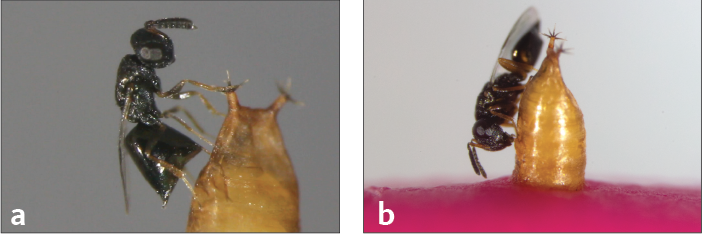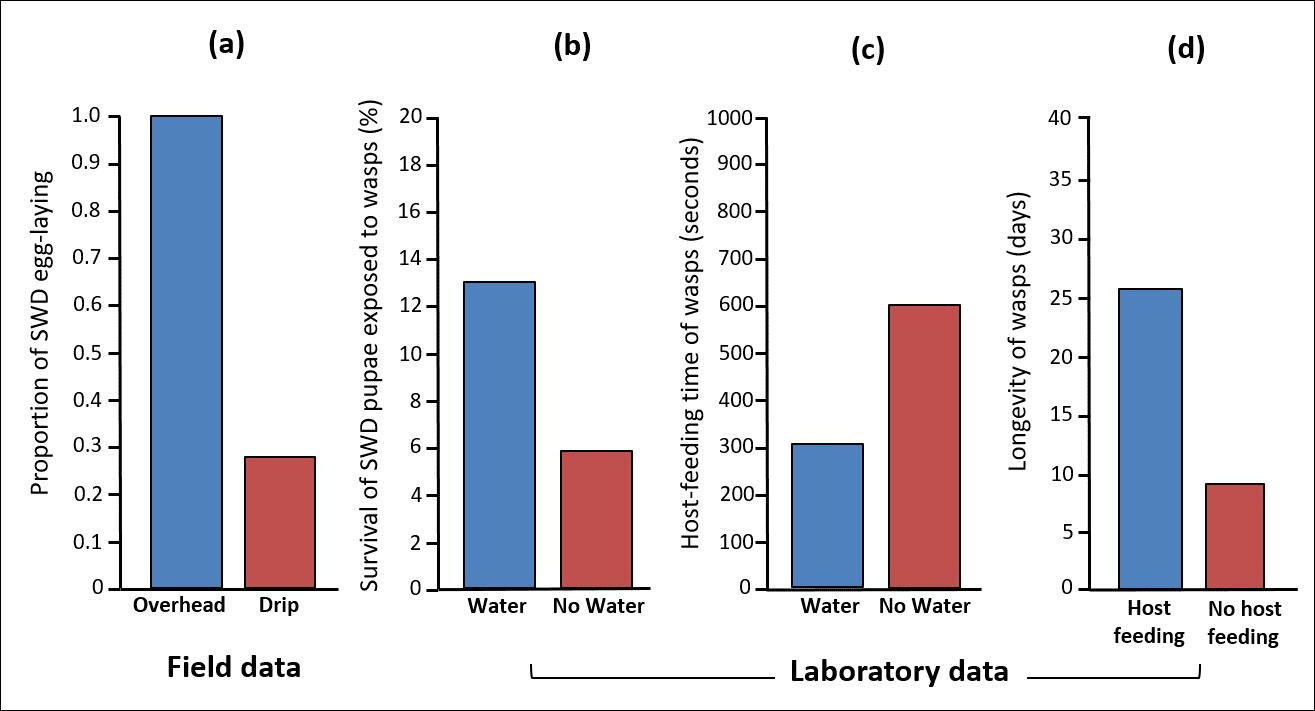SWD series #8
Key points from this fact sheet
- Overhead irrigation increases humidity—creating more favorable conditions for the development of spotted-wing drosophila (SWD) pest populations.
- Drip irrigation can limit conditions that favor SWD population increase.
- Pachycrepoideus vindemmiae is a parasitic wasp (parasitoid) that attacks SWD by laying its eggs on SWD pupa. Drip irrigation may increase parasitism by P. vindemmiae.
- Adult parasitic wasps also lower SWD populations by directly feeding on SWD pupae (host-feeding). Host feeding can increase under drip irrigation.
- The parasitic wasp is well-adapted to attack SWD and may contribute to its control in Oregon.
Wasp helps control SWD
Biocontrol (biological control) is the use of a living organism to control a pest problem. This publication explains how a naturally occurring parasitic wasp in Oregon can help control spotted-wing drosophila in Oregon blueberry production.
Water delivery, and the environmental conditions that water delivery creates, can significantly affect biocontrol in production units. In particular, drip irrigation provides a variety of advantages compared to overhead sprinkler irrigation by affecting SWD development while accurately delivering water and nutrients and reducing weed management costs.
Pachycrepoideus vindemmiae is present in Oregon and able to successfully attack and kill SWD in the field (Figure 1a and Video 1, page 2). These tiny wasps attack pupae of many fly species, and help to control SWD in Oregon.
Under laboratory conditions, an adult P. vindemmiae female can kill up to 600 SWD pupae during its lifespan. This wasp lives longer when water and sugar are available. Adult wasps receiving water and honey lived up to 60 days; those fed on honey alone lived about 30 days. Those provided only water and no honey lived about 10 days.
When other food sources are less available, female parasitoids are able to feed on SWD pupae to obtain the required nutrients. This process, known as “host-feeding,” kills SWD pupae (Figure 1b and Video 2, page 2). Host-feeding occurs after a female wasp stings an SWD pupa and starts feeding on the pupal blood (hemolymph) to supplement water and other nutrients.
Low water availability and low relative humidity result in significantly higher death rates of SWD and reduced egg laying (Figure 2a and Figure 2b). The same conditions increase P. vindemmiae host-feeding on SWD pupae (Figure 2c, page 2).
In dry environments, parasitoids prey at higher rates on SWD than when water is present. Irrigation practices, pruning and other cultural practices including the use of weed fabric, may reduce SWD reproduction and survival. Drip irrigation, particularly, may contribute to the drier conditions that encourage the wasp to attack SWD pupae. These lab and field tests indicate that growers who maintain drier conditions in the fields may see reduced SWD reproduction and survival in their fields.
Further readings
Bezerra Da Silva, C.S., B.E. Price, A. Soohoo-Hui, V.M. Walton. 2019a. Factors affecting the biology of Pachycrepoideus vindemmiae (Hymenoptera: Pteromalidae), a parasitoid of spotted-wing drosophila (Drosophila suzukii). PLOS ONE 14, e0218301.
Bezerra Da Silva C.S., B.E. Price, V.M. Walton. 2019b Water-deprived parasitic wasps (Pachycrepoideus vindemmiae) kill more pupae of a pest (Drosophila suzukii) as a water-intake strategy. Scientific Reports 9, 3592.
Gabarra, R., J. Riudavets, G.A. Rodríguez, J. Pujade-Villar, J. Arnó. 2015. Prospects for the biological control of Drosophila suzukii. BioControl 60, 331–339.
Marchiori, C.H., L.F. Barbaresco. 2007. Occurrence of Pachycrepoideus vindemmiae (Rondani, 1875) (Hymenoptera: Pteromalidae) as a parasitoid of Megaselia scalaris (Loew, 1866) (Diptera: Phoridae) in Brazil. Brazilian Journal of Biology. 67, 577–578.
Miller, B., G. Anfora, M. Buffington, K.M. Daane, D.T. Dalton, K.M. Hoelmer, M.V. Rossi-Stacconi, A. Grassi, X. Ioriatti, A. Loni, J.C. Miller, M. Quantar, X.G. Wang, N.G. Wiman, V.M. Walton. 2015. Seasonal occurrence of resident parasitoids associated with Drosophila suzukii in two small fruit production regions of Italy and the USA. Bull Insectology 68(2): 255–63.
Rendon, D. and V. M Walton. 2019. Drip and overhead sprinkler irrigation in blueberry as cultural control for Drosophila suzukii in Northwestern United States. Journal of Economic Entomology 112, 745–752.
Rossi-Stacconi, M.V., M. Buffington, K.M. Daane, D.T. Dalton, A. Grassi, G. Kaçar, B. Miller, J.C. Miller, N. Baser, C. Ioriatti, V.M. Walton, N.G. Wiman, X.G. Wang, G. Anfora. 2015. Host stage preference, efficacy and fecundity of parasitoids attacking Drosophila suzukii in newly invaded areas. Biological Control. 84: 28–35.
Rossi-Stacconi, M.V., A. Grassi, D.T. Dalton, B. Miller, M. Ouantar, A. Loni, C. Ioriatti, V.M. Walton, G. Anfora. 2013. First field records of Pachycrepoideus vindemmiae as a parasitoid of Drosophila suzukii in European and Oregon small fruit production areas. Entomologia e3.
Wang, X.G., M.A. Serrato, Y. Son, V.M. Walton, B.N. Hogg, K.M. Daane. 2018. Thermal Performance of two indigenous pupal parasitoids attacking the invasive Drosophila suzukii (Diptera: Drosophilidae). Environmental Entomology 47(3):764-772.
Wang, X.G., R.H. Messing. 2004. Two different life-history strategies determine the competitive outcome between Dirhinus giffardii (Chalcididae) and Pachycrepoideus vindemiae (Pteromalidae), ectoparasitoids of cyclorrhaphous Diptera. Bulletin of Entomological Research 94: 473–480.
SWD videos
Video 1: Female wasp inserting her ovipositor through the SWD’s pupal case and performing internal evaluation of the host prior to oviposition. Note the wasp’s ovipositor moving between the SWD pupal case and the pupa. https://doi.org/10.1371/journal.pone.0218301.s004
Video 2: Female wasp host-feeding on hemolymph of a SWD pupa following ovipositor withdrawal. Note the wasp’s abdomen engorging as host-feeding takes place. https://doi.org/10.1371/journal.pone.0218301.s005
About this series
This publication is one of a series of nine publications focused on strategies for controlling spotted-wing drosophila in Oregon. Find them at https://catalog.extension.oregonstate.edu/. The publications in this series include:
- EM 9261: How Seasons Affect Population Structure, Behavior and Risk on Spotted-wing Drosophila
- EM 9262: Cultural Control Strategies to Manage Spotted-wing Drosophila
- EM 9263: Host Range and Characteristics Affecting Fruit Susceptibility to Spotted-wing Drosophila
- EM 9264 Noncrop Host Plants Used By Spotted-wing Drosophila
- EM 9265: Chemical Control of Spotted-wing Drosophila: Spray Applications
- EM 9266: Chemical Control of Spotted-wing Drosophila: Insecticide Efficacy
- EM 9267: Monitoring Techniques for Spotted-wing Drosophila
- EM 9268: Potential Impacts of Irrigation on Biocontrol on Spotted-wing Drosophila Populations
- EM 9269: Biocontrol of Spotted-wing Drosophila
© 2019 Oregon State University.




